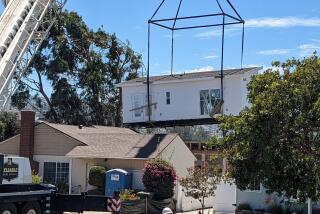Accessory Units Can Ease House Shortage
There is a form of affordable housing that requires no tax subsidy, is integrated into single-family neighborhoods and is accepted in prestigious communities.
It not only helps tenants, but also elderly homeowners, single-parent homeowners, young home buyers and others.
This type of housing, known as accessory units, or in California, as second units, consists of both apartments and cottages.
Accessory apartments are independent housing units created out of the surplus space in single-family homes.
Accessory cottages are separate units created on the same lot as a single-family home.
A survey of 47 communities in the United States that permit accessory units found that they could provide about 50,000 new rental units a year.
Seven studies, including one in Daly City and one in Marin County, have shown that accessory apartments typically rent for less than fair market rent levels set by the Department of Housing and Urban Development with no subsidy or rent control.
How is it possible to create affordable housing in large quantities without subsidy? The answer is by taking advantage of the underutilization of the single-family housing stock.
The 1987 American Housing Survey found that 32% of all homes with five rooms or more, not counting attics, basements or garages, were occupied by two persons or less.
Roughly one out of every three single-family homes, or about 15 million homes, have enough surplus space to accommodate a new rental unit within their walls. Accessory units do not require development of new land. Accessory apartments don’t even require much construction, and cost about one-third as much as to build conventional rental units.
Accessory units provide older homeowners with added income, security, companionship, and, in the case of the frail elderly, the opportunity to trade rent reductions for needed services.
They provide young home buyers with rental income to help meet mortgage payments.
They provide single parents, typically mothers, with rental income to help pay mortgages that assumed two incomes. They provide severely disabled homeowners or disabled adult children with privacy in close proximity to support.
In many people’s minds there is a self-fulfilling assumption that zoning will never be changed to permit accessory units. That assumption will fade in the face of successful ordinances in communities such as Westport and Greenwich, Conn.; Boulder, Colo., and many others. In Westchester County, New York, efforts to amend zoning to permit accessory units have been debated in 12 communities, and have been approved in 11.
A survey I conducted showed that a community with favorable zoning could expect to get one accessory unit per 1,000 single-family homes per year.
Such a rate will be reassuring to civic groups and others who do not want planners and others taking risks with their homes and neighborhoods.
But one accessory unit per 1,000 single-family homes means a big increase in production of affordable rental housing. Applying such a rate to the roughly 50 million single-family homes in the country, we would get about 50,000 new accessory units each year. That would mean an increase of about 14% in the annual production of rental housing and most of those units would be affordable.
Boulder, which first permitted accessory units in 1984, passed the 100-unit mark last year. One hundred units of affordable housing, or even mostly affordable housing, is worthy of a ribbon cutting.
However, to my knowledge, there has never been a ribbon cutting to celebrate accessory units in Boulder or anywhere else. Typically, no one notices.
In most communities that zone for accessory units, the zoning amendment is passed and forgotten. The number of communities that have amended zoning to permit accessory units must now number in the thousands. To my knowledge, not one has reversed its decision to permit them. In fact, in my survey, 11 out of 47 communities had gone back and revised their zoning to make accessory unit permits easier to obtain.
There are problems. Many communities in California and other areas that zoned for accessory units in the early 1980s need to go back and improve their process for permitting accessory units. There now exist many good zoning provisions that provide the oversight desired by civic associations without making homeowners jump over almost impossible hurdles to get zoning approval.
Another problem is that, for homeowners, installing an accessory unit is like buying a car piece by piece at auto parts stores and trying to assemble it yourself. It involves finding a remodeler or builder, getting zoning approval, making design decisions, finding financing, determining a rental rate, finding a tenant, understanding tenant management, tax issues, insurance issues, etc.
These are new problems to most homeowners. None of them by itself is necessarily overwhelming. All together, however, they often mean homeowners face a learning curve that is more like a learning wall.
There is a need for a service that helps homeowners get through the process of installation. Many groups could take the lead in providing that service. The professions and groups that stand to benefit from accessory units include remodelers, real estate agents, bankers, aging groups, single-parent groups, hospital discharge planners, home health care agencies, new home builders, affordable housing groups, disabled groups and others.
Leadership is needed to bring those groups together to help homeowners, and to hold the groups together long enough for them to see the financial and social returns from accessory units.
In the past, fears of accessory units scared elected officials. But it would be hard to condemn an elected official for providing leadership on a housing type that helps homeowners of all kinds, creates affordable homes without subsidy, and is already accepted in prestigious communities.
More to Read
Sign up for Essential California
The most important California stories and recommendations in your inbox every morning.
You may occasionally receive promotional content from the Los Angeles Times.






